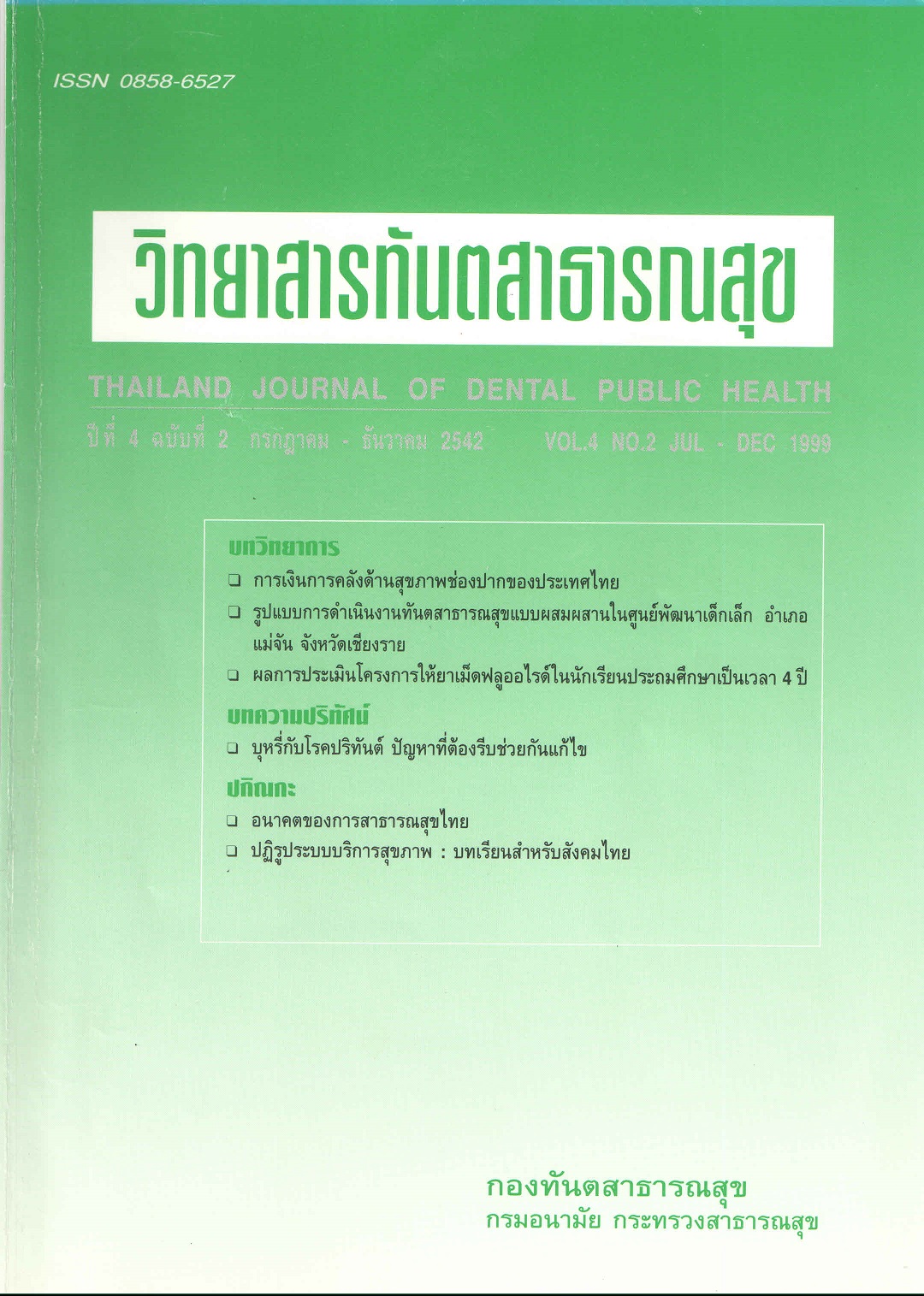Use of fluoride tablets in primary schools after 4 years implementation.
Main Article Content
Abstract
This study aims at evaluating the project “Use of fluoride tablets in primary school” after 4 years of implementation focusing on the coverage of children and how the project is implemented. Samples are drawn from 4 provinces namely Samut Prakan, Ratchburi, Trad and Pang-Nga using multistage sampling technique. Totally samples are 1,245 children, 41 teachers, 4 dental nurses from Provincial Health Office and 8 dental personnel from Community hospitals. Instruments used are 4 tested interview guidelines. Findings show that children aged 6-14 years old, averages 8.93 years old. Children 91.4 % have knowledge that fluoride prevents dental decay. Percentages of children taking fluoride tablets in 4 provinces range 93 -97, on average are 95.2. Among these 66.6 % have fluoride tablets every school day, 35.8 % and 41.6 % have taken tablets for 2 and 3 years and more respectively. Children 69.3 % chew/swish the tablets before swallow. 38.9 % are given the tablets by class/student leaders and 85.9 % like to take the tablets because of its taste and usefulness. 96.1% use fluoride toothpaste. Teachers' interviews show that nearly all of them are trained before starting the project. Most of responsible teachers allocate fluoride tablets to classroom teachers and later the class/student leaders will be assigned to give tablets to other children. Most of teachers have good knowledge on fluoride except the symptom and treatment of acute toxicity of fluoride over dose. They state that use of fluoride tablets in primary schools is easy to manage. Problems found are that teachers are confused with various size and color of fluoride tablets. Some say they got too much amount of fluoride tablets. Dental personnel's interview reveal that 2 provinces allocate fluoride tablets through Office of Education at provincial and district level while the others allocate through Community hospitals and health centers. Monitoring tool is the teachers' monthly report used in 3 provinces. Besides, school visits are done 1-2 times a year by health team. It is suggested that the dental team at provincial and district level should pay attention more on monitoring and preparation for the evaluation its impact on oral health. It is also suggested that the fluoride tablets package should be packed in a smaller size.
Downloads
Article Details
References
2. Horowitz HS, Meyers RJ, Heifetz SB, Driscoll WS, LISH. Combined fluoride, school-based program in a fluoride-deficient area: results of 11-year study.J Am Dent Assoc 1986 May;112(5):621
3. Driscoll WS, Nowjack-Raymer R, Heifetz SB, LiSH, Selwitz RH.Evaluation of the comparative effectiveness of fluoride mouthrinsing, fluoride tablets, and both procedures in combination:interim findings after five years. J Public Health Dent 1990 Winter;50(1):13-7
4. Driscoll WS, Nowjack-Raymer R, Selwitz RH, LISH, Heifetz SB. A comparison of the caries preventive effects of fluoride mouthrinsing, fluoride tablets, and both procedures combined :final results after eight years. J Public Health Dent 1992 Winter;52(2):111-6
5. Stephen KW, Kay EJ, Tullis Jl. Combined fluoride therapies. A 6-year double-blind schoolbased preventive dentistry in Inverness, Scotland. Community Dent Oral Epidemiol 1990 Oct; 18(5): 244 -8
6. Driscoll WS, Heifetz SB, Brunelle JA. Caries-preventive effects of fluoride tablets in school children four years after discontinuation of treatments. J Am Dent Assoc 1981 Dec;103(6): 878-81
7. กองทันตสาธารณสุข กรมอนามัย, โครงการให้ยาเม็ดฟลูออไรด์ในนักเรียนประถมศึกษา 2536 เอกสารโรเนียว
8. กรมอนามัย กระทรวงสาธารณสุข. รายงานการประเมินผลแผนงานทันตสาธารณสุขตามแผนพัฒนาการสาธารณสุขฉบับที่ 7 (พ.ศ. 2535-2539), 2541 กรุงเทพ: โรงพิมพ์องค์การสงเคราะห์ทหารผ่านศึก
9. ขวัญรักษ์ อยู่สมบูรณ์ และคณะ, ความรู้ ทัศนคติ และการมีส่วนร่วมของครูในงานเฝ้าระวังทันตสุขภาพในนักเรียนประถมศึกษา อ.กุสุมาลย์ จ.สกลนคร 2535 เอกสารเย็บเล่ม
10. Primosch RE, Weatherell JA, Strong M. Distribution and retention of salivary fluoride from a sodium fluoride tablet following various intra-oral dissolution methods. J Dent Res 1986 Jul; 65(7): 1001 - 5
11. วรวรรณ อัศวกุลและคณะ, การดําเนินงานเฝ้าระวังและส่งเสริมทันตสุขภาพในโรงเรียนประถมศึกษาที่ได้รับการคัดเลือกเป็นโรงเรียนดีเด่นเฝ้าระวังทันตสุขภาพและโรงเรียนที่ไม่ได้รับการคัดเลือกเป็นโรงเรียนดีเด่นเฝ้าระวังทันตสุขภาพ 2536 กองทันตสาธารณสุข กรมอนามัย เอกสารเย็บเล่ม
12. Rossow I, Holst D. Use of fluoride tablets in childhood: a 10-year prospective study. J Public Health Dent 1993 Summer;53(3):146 – 50


